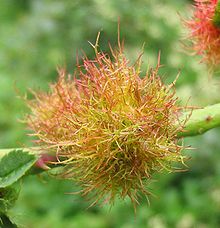
Diplolepis is a genus of approximately fifty species of gall-inducing wasps in the family Diplolepididae. The larvae induce galls on wild roses (Rosa), and rarely on domestic roses.

A hyperparasite, also known as a metaparasite, is a parasite whose host, often an insect, is also a parasite, often specifically a parasitoid. Hyperparasites are found mainly among the wasp-waisted Apocrita within the Hymenoptera, and in two other insect orders, the Diptera and Coleoptera (beetles). Seventeen families in Hymenoptera and a few species of Diptera and Coleoptera are hyperparasitic. Hyperparasitism developed from primary parasitism, which evolved in the Jurassic period in the Hymenoptera. Hyperparasitism intrigues entomologists because of its multidisciplinary relationship to evolution, ecology, behavior, biological control, taxonomy, and mathematical models.
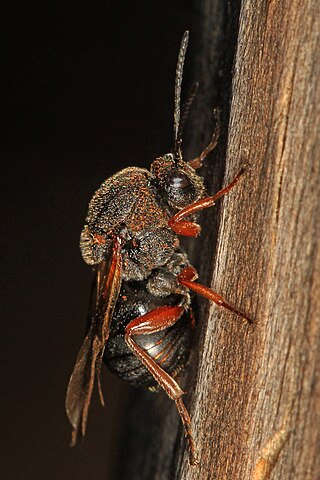
Gall wasps, also traditionally calledgallflies, are hymenopterans of the family Cynipidae in the wasp superfamily Cynipoidea. Their common name comes from the galls they induce on plants for larval development. About 1,300 species of this generally very small creature are known worldwide, with about 360 species of 36 different genera in Europe and some 800 species in North America.

A gall-inducing insect is any insect that can cause the growth of galls within plants. There are several groups of insects that meet this description. They include the gall wasps, scales, gall midges, aphids, psyllids and certain species of leafminer flies.
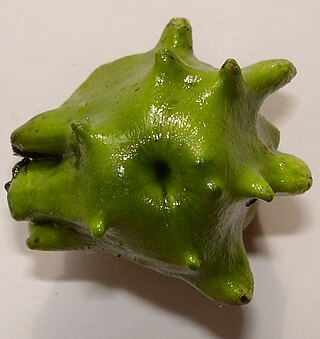
Andricus quercuscalicis is a gall wasp species inducing knopper galls.

Andricus kollari, also known as the marble gall wasp, is a parthenogenetic species of wasp which causes the formation of marble galls on oak trees. Synonyms for the species include Cynips kollari, Andricus quercusgemmae, A. minor, A. indigenus and A. circulans.

Andricus foecundatrix is a parthenogenetic gall wasp which lays a single egg within a leaf bud, using its ovipositor, to produce a gall known as an oak artichoke gall, oak hop gall, larch-cone gall or hop strobile The gall develops as a chemically induced distortion of leaf axillary or terminal buds on pedunculate oak or sessile oak trees. The larva lives inside a smaller hard casing inside the artichoke and this is released in autumn. The asexual wasp emerges in spring and lays her eggs in the oak catkins. These develop into small oval galls which produce the sexual generation of wasps. A yew artichoke gall caused by the fly Taxomyia taxi also exists, but is unrelated to the oak-borne species. Previous names or synonyms for the species A. fecundator are A. fecundatrix, A. pilosus, A. foecundatrix, A. gemmarum, A. gemmae, A. gemmaequercus, A. gemmaecinaraeformis and A. quercusgemmae.
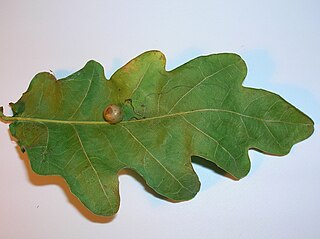
The red-pea gall or red currant gall develops as a chemically induced distortion arising from the underside of the mid-rib of a vein on Quercus species and it is attached by a short stalk or peduncle. The red-wart gall is the sexual phase of the same species.

A wasp is any insect of the narrow-waisted suborder Apocrita of the order Hymenoptera which is neither a bee nor an ant; this excludes the broad-waisted sawflies (Symphyta), which look somewhat like wasps, but are in a separate suborder. The wasps do not constitute a clade, a complete natural group with a single ancestor, as bees and ants are deeply nested within the wasps, having evolved from wasp ancestors. Wasps that are members of the clade Aculeata can sting their prey.

The common spangle gall on the underside of leaves and the currant gall on the male catkins or occasionally the leaves, develop as chemically induced distortions on pedunculate oak, or sessile oak trees, caused by the cynipid wasp Neuroterus quercusbaccarum which has both agamic and bisexual generations.
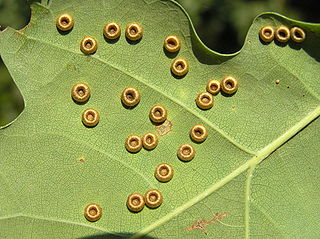
Neuroterus numismalis is a gall wasp that forms chemically induced leaf galls on oak trees. It has both bisexual and agamic (parthenogenetic) generations and forms two distinct galls on oak leaves, the silk button gall and blister gall. The galls can be very numerous with more than a thousand per leaf.
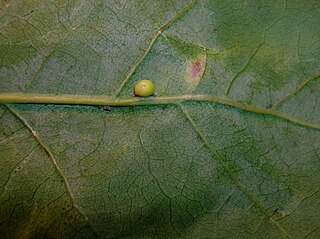
Neuroterus anthracinus is a widely distributed gall wasp that forms chemically induced leaf galls on oak trees. N. anthracinus has both sexual and agamic generations and in consequence forms two distinct galls, the oyster gall and April-bud gall.

The nettle pouch gall develops in leaf veins, leaf petioles, flower stalks and sometimes the stem of Urtica dioica and Urtica urens. This structure is caused by the gall midge or gnat Dasineura urticae, also spelled Dasyneura urticae. Synonyms are Perrisia urticae and Cecidomyia urticae.
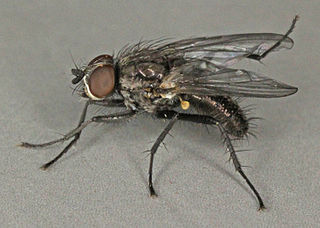
Chirosia betuleti is a species of fly, which causes knotting gall in ferns. The gall develops in the terminal shoots of ferns, such as broad buckler fern, male fern, lady fern, and ostrich fern.

Andricus quercuscalifornicus, or the California gall wasp, is a small wasp species that induces oak apple galls on white oaks, primarily the valley oak but also other species such as Quercus berberidifolia. The California gall wasp is considered an ecosystem engineer, capable of manipulating the growth of galls for their own development. It is found from Washington, Oregon, and California to northern regions of Mexico. Often multiple wasps in different life stages occupy the same gall. The induced galls help establish complex insect communities, promoting the diversification in niche differentiation. Furthermore, the adaptive value of these galls could be attributed their ecological benefits such as nutrition, provision of microenvironment, and enemy avoidance.

Diplolepis mayri is a gall inducing insect causing galls on wild roses in the Western Palaearctic. Diploleis mayri is less frequent on rose shrubs than D. rosae.
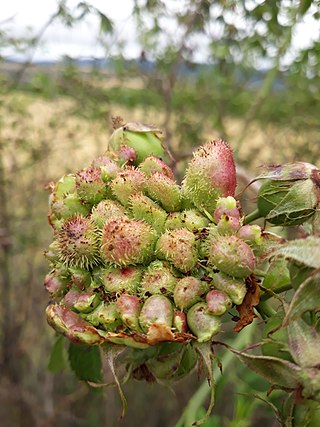
Diplolepis fructuum is a hymenopteran gall wasp which causes a galls on wild roses. The species is closely related to D. rosae and D. mayri but it produces its galls in the seeds of wild roses thus damaging its hips. The species is distributed mainly in the Northern regions of the Middle East, the Caucasus region and Northern shores of the Black Sea.

Diplolepis ignota is a species of gall wasp (Cynipidae). Galls in which the larvae live and feed are formed on the leaves of several species of wild rose (Rosa). Individual galls are single-chambered and spherical, but multiple galls can coalesce into irregularly rounded galls.
Andricus mukaigawae is a species of gall wasp native to southeastern Asia. It creates galls on the buds and leaves of oak trees. The galls are sometimes used by other gall wasps unable to create galls of their own, with both species sharing the gall.
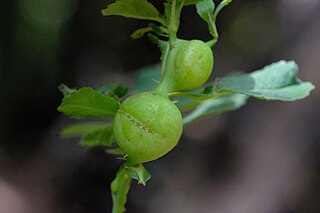
Diplolepis nodulosa, also known as the rose-stem gall wasp, is a species of cynipid wasp that induces bud galls on wild roses in North America. This galls induced by this species have a number of inquilines and parasitoids. D. nodulosa is assigned to a clade of Nearctic stem gallers within Diplolepis along with Diplolepis californica, Diplolepis oregonesis, Diplolepis spinosa, and Diplolepis triforma.
